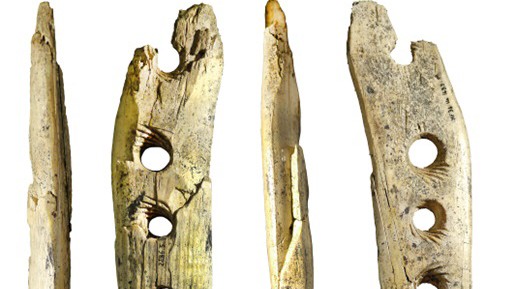Five meters of rope in ten minutes: Two perforated rods discovered in the Swabian Alb are unique in the world and were apparently used to make rope at least around 35,000 years ago. This is what archaeologist Nicholas Conard from the University of Tübingen and Veerle Rots from the University of Liège report after conducting corresponding experiments in the journal Science Advances.
In 2015, paleontologists working with Conard discovered fragments of a perforated rod made of mammoth ivory in the Hohler Fels karst cave in the Achtal in the Alb-Donau district in Baden-Württemberg. The material alone is unusual, as such objects were almost always made from the antlers of reindeer and deer. What is particularly unusual, however, is the fact that the perforated rod contains four holes. In other finds in Europe there were usually one or a maximum of two holes. A very similar object from the same era has only been found once before, in 1983 in the Geißenklösterle cave, two kilometers away.
The hollow rock hole stick that has now been presented in detail is 35,000 to 40,000 years old, a good 20 centimeters long, more than three centimeters wide and one and a half centimeters thick. The four holes with a diameter of seven to nine millimeters are notched in a spiral shape. From this, Conard and Rots draw conclusions about the previously mysterious function of the two special perforated rods. Until now, experts have considered them to be symbols of power or art objects; they were only considered to have practical value as levers, similar to the bottle opener principle.
“Without rope, cord or strips of leather, life in the Stone Age would have been difficult.”
After practical tests, Conard and Rots now report that the four-hole objects are well suited to making ropes, especially from cattail leaves (Typha), a group of plants that was probably already growing in the Achtal at that time. In corresponding experiments, four to five people were able to make a rope of up to five meters from cattail leaves within ten minutes, which was about the thickness of a finger. To do this, the already twisted leaves are pulled through the holes and the resulting strand is twisted again.
“That doesn’t disprove that perforated rods could have a symbolic meaning,” Conard said. “But it shows that they also had practical value as tools.” The expert points to the considerable technical skills of the people of that time. Their products included both jewelry and art objects, and flutes made of ivory and bird bones that were around 40,000 years old were discovered in the two caves in the Swabian Alb – the world’s oldest musical instruments.
“Anyone who camps, hunts, or gathers today knows that ropes and cords are useful for countless practical purposes,” write Conard and Rots. “Without rope, cord or strips of leather, life in the Stone Age would have been difficult.”

